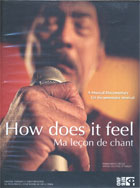
How Does It Feel 2011
Distributed by National Film Board of Canada, 1123 Broadway, Suite 307, New York, NY 10010; 800-542-2164
Produced by Annette Clarke
Directed by Lawrence Jackman
DVD , color, 35 min.
Sr. High - General Adult
Art, Biography, Communication, Disability Studies, Health Sciences, Music, Psychology, Sociology
Date Entered: 04/10/2013
ALA Notable: yes
Reviewed by Meghann Matwichuk, Morris Library, University of Delaware
How Does It Feel is a uniquely personal portrait of one man’s struggle to express his personality and creativity despite the physical challenges of cerebral palsy. Kazumi Tsuruoka is a 58-year old Canadian whose speech and motor control limitations have not stunted his insight, intellect, and passion for self-expression through music. Interviews with Kazumi and his vocal coach, Fides Krucker, are intercut with their lessons and footage from his performances.
The film is an immersive experience for the viewer, using subjective perspectives and artistic presentation to draw the viewer into Kazumi’s world. His performances add layers of meaning to blues and jazz standards by the likes of Smokey Robinson, transforming break-up songs into poignant reflections about living as a disabled person. At the start of the film, Kazumi sings, “People say I’m the life of the party / Deep inside, I’m blue.” As he explains in his own words, “When you’re a minority, you’ve got to please people to survive… But you’re not happy with yourself because you’re still a little kid wanting approval.” He later talks about his struggle with alcohol dependency, which stemmed from a need to self-medicate as a way of coping with his feelings of rejection, loneliness, and exposure. Many of Kazumi’s observations are relatable to anyone who has ever had feelings of isolation or not belonging. This makes the film both universal and instructional. The viewer is likely to take away a new perspective on how he or she might relate to individuals with physical disabilities.
Kazumi discusses the restrictions he and others in his condition face, due to poverty and other factors. “We have to live a restricted life… We hijack our passion.” In a bid to reclaim his passion, he challenges societal expectations by performing his songs publicly. He willfully contradicts his friends who claim, “People like us can’t sing.” With an art group called CP Salon and at a public park, he brings his expressive style to a wide audience. On the heels of his admissions of self-doubt and coupled with his observations that “[the able-bodied] are scared” by disabilities, the panache and bravery of his performances are striking. Kazumi creates opportunity for both himself and the public to examine their preconceived notions. In capturing his story, director Lawrence Jackman constructs a paean to the power and universality of art as a tool for healing and communication. The resulting film will be of interest for those examining a variety of disciplines, including disability studies, art and music therapy, and sociology.